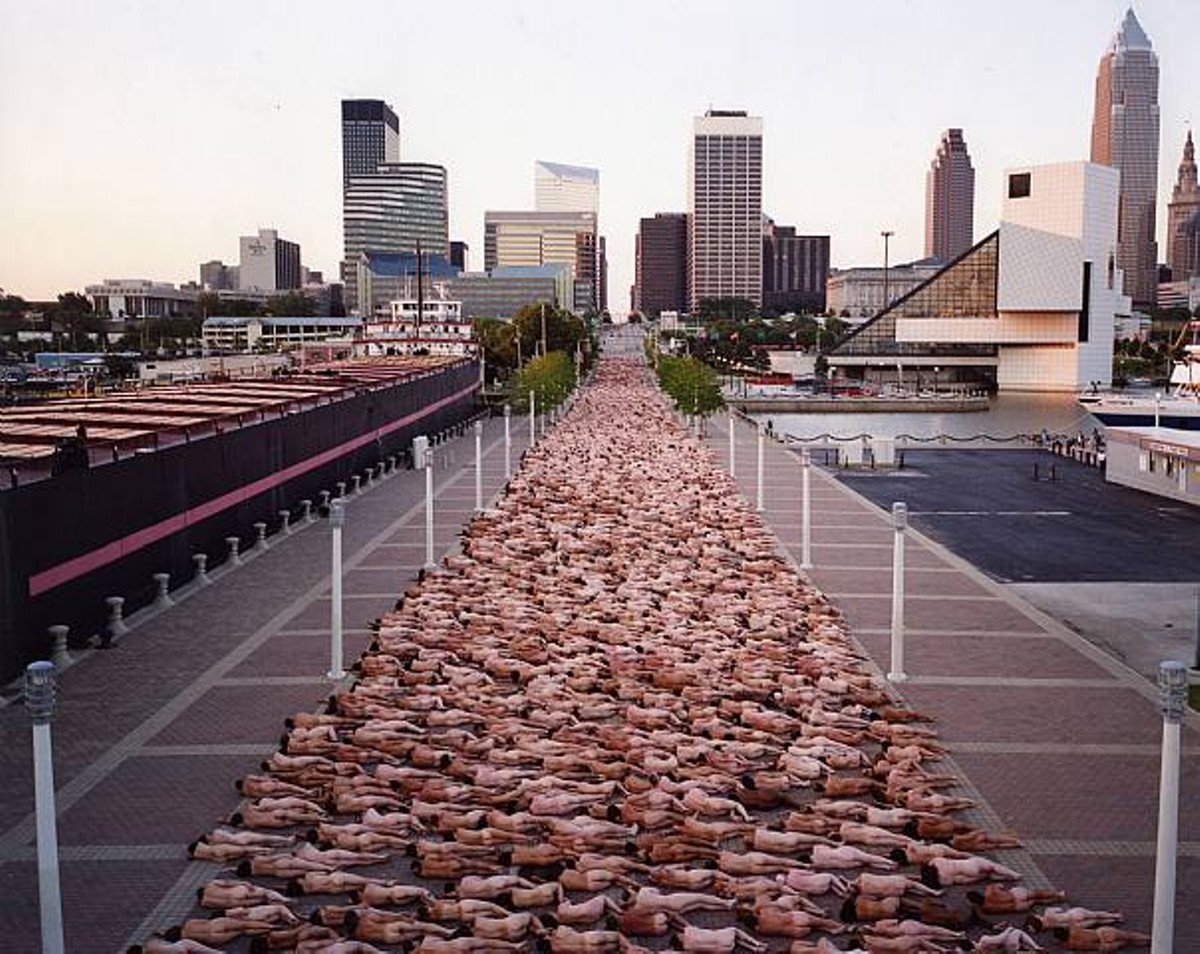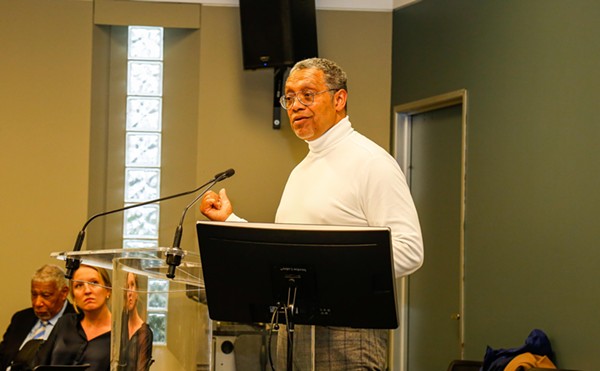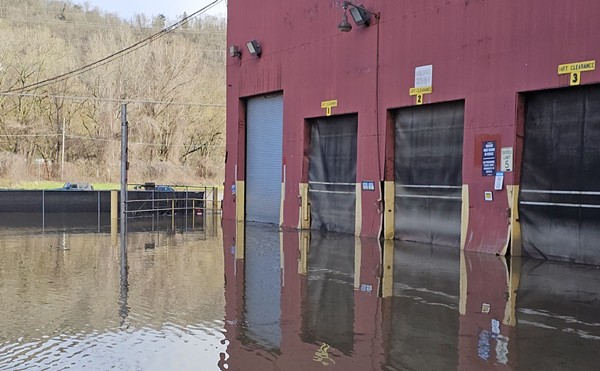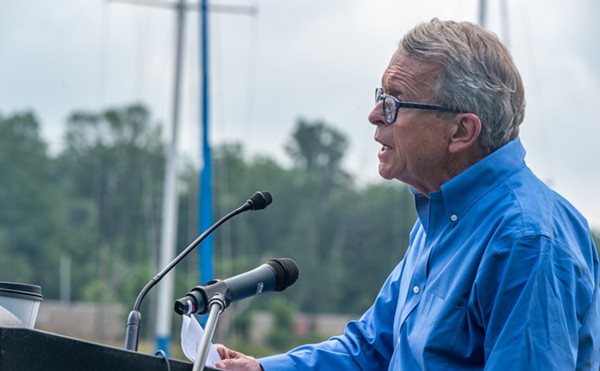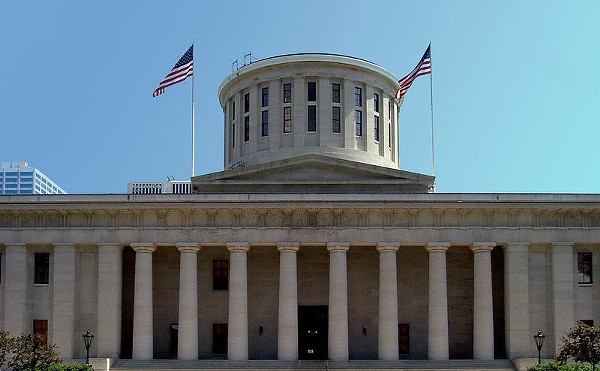Photographer Spencer Tunick specializes in large-scale nude shots, a kind of temporary installation that includes anywhere from a few hundred to a few thousand naked souls in a variety of settings. The 49-year-old artist, who now lives in upstate New York with his wife and daughters, has produced more than 75 of these shots. One of those, you'll remember, was in Cleveland back in 2004. Tunick, with the help of MOCA Cleveland, gathered 2,500 men and women on the East Ninth Street pier.
Twelve years later, we caught up with Tunick as he announces his plans to return to Cleveland for another mass nude installation. Far smaller in scope this time — 100 women — and on private property, the shoot is set for sunrise on Sunday morning, July 17, the week of the Republican National Convention. We talked to him about why the location and the shot are so important to him.
Scene: We're still a ways out from the RNC, and you're obviously working on that shot, but what else are you working on right now?
Spencer Tunick: I'm trying to organize about 6,000 people to pose in Bogota, Colombia, for a shot. We have around 12,000 people already signed up. That generally means about half of them will show up. We're trying to orchestrate that with the Museum of Modern Art Bogota. That's going to happen the first week of June. The location for the installation will be announced about a week beforehand.
And about a month later you'll return to Cleveland. What was the genesis of the idea to do a shot the week of the Republican National Convention and how long has this been in the works?
I've always wanted to do large installation works. It's not necessarily a title I gave to the work, because it's really a cross between photography and an installation and a performance. It's easier to qualify them as installations, albeit temporary.
I was thinking about doing some work in D.C. I wanted to document the works in a film version, not so much a documentary, but a film that would have a combination of documentary and animation. Sort of fantasy scenes. Not sci-fi per se, but dreamlike in scenes that don't really exist. I wanted to have John Quincy Adams walking from the White House and jumping in the Potomac River naked and skinny-dipping, for example. I had this idea to have conceptually and physically impossible works with the body in a fantasy scene, a mosaic art film that would document the installation.
And then I saw a wonderful film called Chicago 10, directed by Brett Morgen. [Ed. note: The 2007 film combines archived materials and current commentary to explore the demonstrations of the infamous 1968 Democratic Convention in Chicago.] I had asked him about his film and if he'd be interested, and he was busy but referred me to others, and I sort of let the project go for the time being.
What brought the idea back?
In 2013, I was at Burning Man and a friend had a mirror that was about 10-inches wide and was posing for me in the desert. She was reflecting her face in the mirror and I was doing a nude and I started thinking if I came back to the desert with 300 or 400 women holding spheres, I could make a really powerful work when the sun rises. So I applied for a grant from Burning Man, the idea being using the grant money to purchase the spheres, and I got turned down. But the idea was to get these spheres for an eventual installation at the RNC. In a way, I was going to do the desert work to fund the RNC work. I couldn't believe I got turned down: I thought Burning Man would want to push the boundaries of their enclosed area in Nevada, and I thought it was a reasonable way to help an artist out. So I sucked it up and decided to do it on my own, basically.
So the film connected with the RNC, which connected with the conception of this mirror idea.
It was Chicago 10 and the history of protest and art in action, at conventions, that I loved.
When I was arrested in New York for my works — illegally I should add; it's legal to work with the naked body on New York streets; Guilliani had instructed the police commission to instruct the police to arrest me and the participants even though it was legal — I had met William Kuntsler, who was portrayed in the film and represented activists. Ron Kuby was his law partner and Ron became my lawyer for five incidents I had with the police.
I never really do protest work. And I thought maybe I don't want Cleveland to be a protest work. Maybe I want it to be a work that women can be part of, maybe to heighten the idea that women will decide the outcome of this election and will have a more powerful presence in the future of politics, the future of the country, and the future of the world. It's not so much a protest but an action, a wake-up call to the absurdity of politics and discrimination.
The deplorable rhetoric from Trump and others against women during the campaign had to play a part.
I spent a lot of time with my wife working on the language for the website [spencertunickcleveland.com]. I wrote it with her and the work is for my daughters, for their future, for them not to grow up in a society with hate, for them to grow up in a world with less violence toward women and more opportunities for them. And there are other subject matters, concerning the environment for instance, and I think people can read into the final photograph and get their own message out of the work and the idea of this ray of light extending over the city. It's sort of to energize the city, to heat it up, and this ray of light bringing knowledge and helping maybe to tone down the rhetoric of hate and prejudice against women preceding the convention.
[The language from the website includes the following: "The photograph will involve 100 nude women holding large mirror discs, reflecting the knowledge and wisdom of progressive women and the concept of "Mother Nature" into and onto the convention center, cityscape and horizon of Cleveland. The philosophy of the artwork relates to the idea of the sacred feminine. By holding mirrors, we hope to suggest that women are a reflection and embodiment of nature, the sun, the sky and the land. We want to express the belief that we will rely upon the strength, intuition and wisdom of progressive and enlightened women to find our place in nature and to regain the balance within it. The mirrors communicate that we are a reflection of ourselves, each other, and of the world that surrounds us. The woman becomes the future and the future becomes the woman.
"Inclusion, participation and interactivity are, and always have been, an integral aspect of Spencer's art. He cannot make his art without the collaboration of the participants. The experience of the individual posing in a mass group nude art installation is as varied as the body types that exist within the works. Everyone has their own experience and story that they bring to the moment and the story and interactivity is always a subtext of the work at large. Spencer's art provides a unique opportunity for artists and non-artists alike to take part in the creation of a contemporary work of installation/performance art and to become the medium itself. The way in which the participants take part in this collective artwork has a transformational effect both on the individual and the collective."]
And working on private property and with a smaller group was probably the only way to get this done during the convention?
Yes, and I'm excited about this one and coming back. I needed to make the work and keep the participants safe. So we picked a location that was far enough away that it could be executed without problems from the police and to not make it a protest of sorts. I just want to get it done. I don't want to hassle with permits, and there are probably lots of people trying to get as close as possible to the event. My work is an art action, and I just want to get it done. That's why I want to work with 100 people.
You said 'coming back,' and that works in a couple of ways. Your wife is from Akron.
Yeah, Kristin's from Akron. She was walking down the street in 1993, on St. Mark's in New York, and at the time I was doing individual group portraits on the street. I would meet people in cafes or bars or as I walked down the street. The streets were my art store; people were my medium. I would look for people I wanted to shoot. I saw her and thought she was amazing. I asked her to pose for me. I was so nervous at the time that I forgot to mention it was a nude. I gave her my card; she never called. A year later, I ran into her and I remembered asking her to pose and I did again. Nothing. A year after that I saw her again and asked her again, and in the meantime her boyfriend had taken her to an exhibition of my work. She said yes, and we just enjoyed hanging out. I never thought it would happen that way but back when I first met her, I did turn to my friend and say, "I'm married." It became a thing that day, looking at people on the street and deciding whether we could spend the rest of our lives with them. I wondered why I said it at the time, but it happened.
And you're coming back in another sense: You did a large installation in 2004 on the pier, and it was your first legally sanctioned work in America outside of New York City at the time, right?
Yes, through some people from the Akron Art Museum we connected with the director of MOCA Cleveland, Jill Snyder, and started talking about my work and she was interested in doing some work with me. I didn't think it would be possible. It just felt like outside of New York it wouldn't work. But almost 2,500 people posed. I thought it might be 300, but I was very surprised that the mindset of the body in America and people's openness to be nude and pose nude was there. There was this unconscious need for people to express themselves through their body.
What's the difference in attitudes between, say, Bogota and New York and Ohio?
I often think New York is jaded as far as everyone is comfortable and used to the body, especially now where the nude in public seems to be like it's always been there. Maybe if I never did my work it'd be different, but every photographer now has a nude on the street or in public in their repertoire. And we know about it a lot more now because of the internet. But pre-1995, you had to search obscure books in art libraries to see it. I think everyone's used to having access to the naked body on the internet, and in images, and on television, and in movies, and in magazines. There's freedom because of the efforts of Larry Flynt, as well as people like Robert Mapplethorpe, and more freedom for museums to show works inside. But outside, the body is still a lightning bolt. It's still very much a taboo area. And that's my terrain; that's my canvas. If I do a work in South America, people will embrace it because they enjoy my works as visual objects, but the fact that they're doing it, the fact that the government is open to the idea, is a major step toward many other freedoms. It's not as jaded as New York. In America, I can still be arrested in most states for what I do.
How can people volunteer to be models for this?
People will submit a photo — it doesn't have to be a nude — and I'll choose 100 women. I want people of all shapes and sizes and ethnicities and skin tonalities. People can also submit some writing on why they want to participate and those, in my experience, have been really powerful. They come with all these stories and body issues and political issues and their motivations. It's quite interesting.
Does the city know this is happening?
Not yet. That's what Scene is for. I'm very excited about this one, just to see what happens and people's reactions, to see whether they get behind it or come against it. Either way, in the end, there will be this really solid artwork that will last forever. It's not just a flash. It's something solid and hopefully meaningful in my family's eyes. I have the support of the museums there, the good people of Cleveland, those who have posed before, and I think it's going to shine a little wisdom on the convention.
For more information on the project or to sign up to pose, visit spencertunickcleveland.com.

